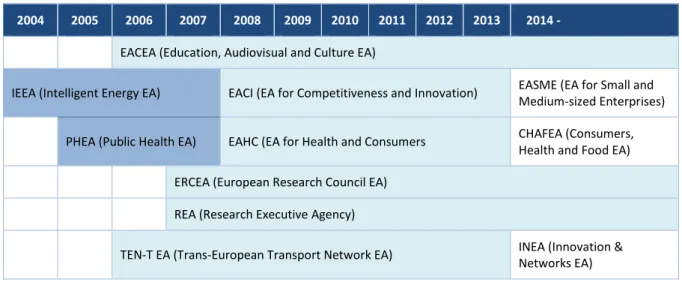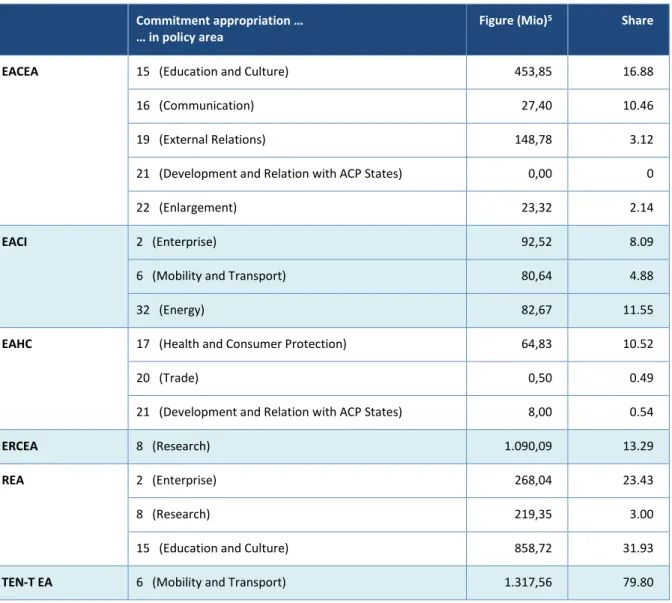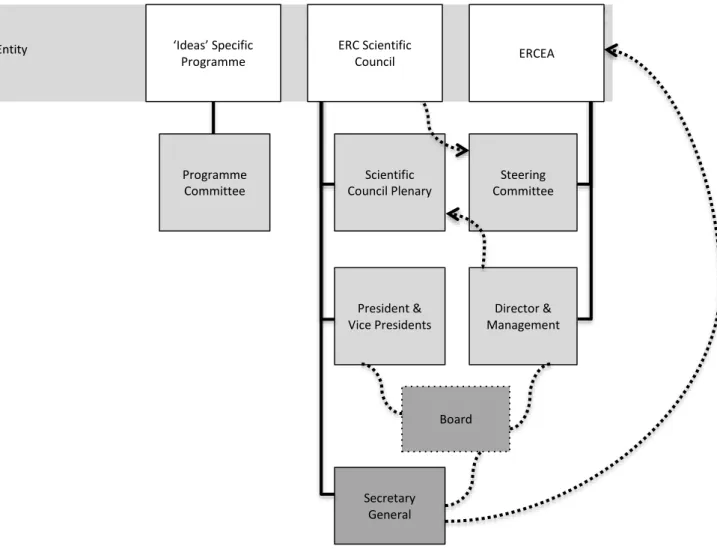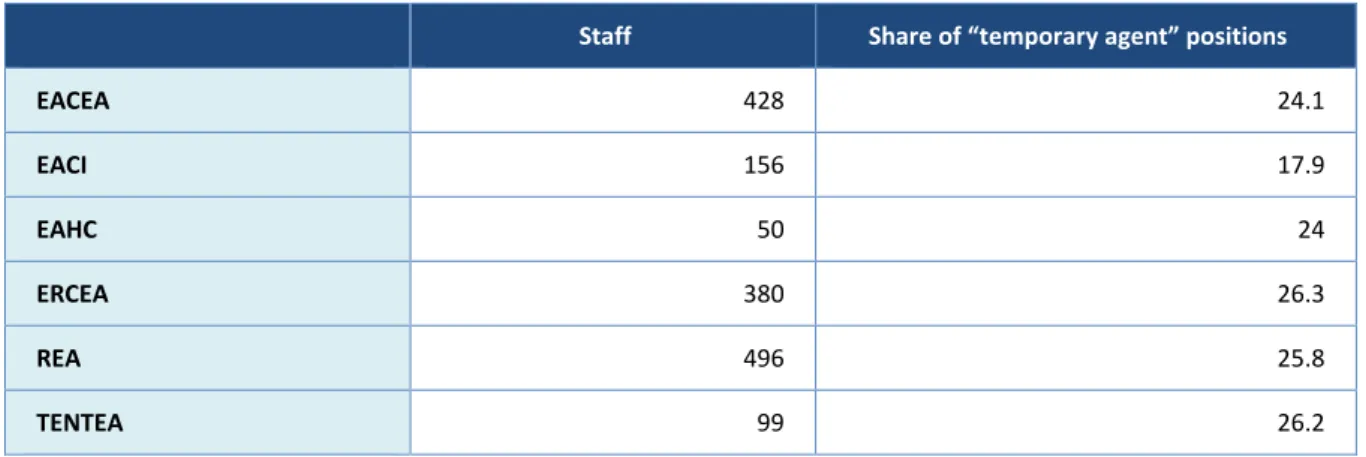Citation
König, T. (2015). ‘Funding Frontier Research: Mission Accomplished?’, Journal of Contemporary European Research. 11 (1), pp. 124-135.
European Research
Volume 11, Issue 1 (2015)
Commentary
Funding Frontier Research: Mission Accomplished?
Thomas König Institute for Advanced Studies, Vienna
Abstract
Despite many warning voices pointing to the organizational weaknesses of this instrument, the European Research Council (ERC) is considered a success story of European research policy. How did that come about? This research note takes a look inside the ERC’s administrative body, the ERC Executive Agency. Based on personal experience, the text provides information how tensions between scientific and administrative expectations towards the performance of this agency could be alleviated, and how a unique social fabric consisting of double compliance, complementary efficiency, and two- tier loyalty emerged. The note ends with some cautious remarks concerning the ERC’s future.
Keywords
European Research Area; Research and Development; organizational theory; science and politics;
European research policy
The European Research Council (ERC) has been carefully watched by advocates (Winnacker 2012; Celis and Gago 2014) as well as scholars from different disciplines (Groß, Karaalp and Wilden 2010; Lorz and Payandeh 2012; Nedeva 2013; Luukkonen 2014). One particular concern regards the mismatch between the institutional format chosen for running the ERC and the specific needs and requirements of a basic research-funding organisation (Vike-Freiberga et al. 2009; Hofmann 2012).
1As a recent study on the process of “institution building” of the ERC notes, in the beginning there was ‘tension between the academic community’s perception of due procedures […] and the way in which they were practised across the range of EU spending activities’ (Gornitzka and Metz 2014: 100).
The studies mentioned above either concentrate on the early phase of the ERC or on the interpretation of its legal foundations. This research note takes a different stance. It aims at answering the question how the resulting tensions actually ‘alleviated over time as the institution gains experience’ (Gornitzka and Metz 2014: 101). Its focus is on the ERC Executive Agency, because it was within this administrative body where the tensions were mostly alleviated. Over the course of four years (2010- 2013), I have been working at the agency’s premises as a scientific advisor to the President of the European Research Council. While this role was not formally foreseen in the legislation defining the Scientific Council (European Commission 2007), I have been involved with decision-making at the top of the ERC. My work also led to numerous encounters with agency management and staff, and I have observed many parts of the agency’s business. However, since I have not been a member of the ERCEA staff, I did not have access to management meetings, and I was not exposed to communication within the agency. In this unique position as an “inside outsider”, I have observations that would allow me to elaborate how the ERCEA managed to deal with these different expectations.
2Put broadly, the scientific and the administrative world have different understanding in how things
should be run. Bureaucratic organizations are expected to fulfil their tasks following administrative
measures; this is even more so the case with an agency that is set up along principles commonly known
as “new public management”. The scientific world, on the other hand, expects swift solutions in order
to open up space for research projects, particularly if those are expected to tackle the frontiers of
science, often without seeing the broader implications of such an ad-hoc approach. The expectations
differed in regards to compliance with rules, efficiency of getting things done, and loyalty towards the
institution. In a way, this is a version of the old contradiction between scientific unpredictability vs.
well-defined procedures in bureaucracies.
Looking at how the ERCEA adapted to the specific needs of the ERC will provide a better estimate whether it is the appropriate format for the long term; it will also provide insights to the more general question, that is, whether the institutional formats currently available in the European administrative space (Balint, Bauer and Knill 2008: 678) are generally suitable to the policy instruments emerging in science policy. The remainder of this note is structured in the following way: it first shows some general features of the executive agency format; then I will discuss at three instances how the agency format had to be adapted in order to conduct the daily business of the ERC; finally, I will provide some preliminary conclusions.
WHAT ARE EXECUTIVE AGENCIES?
In the early 2000s, the European Commission drastically redefined its organizational identity (European Commission 2000; Kinnock 2004; Kassim 2008). Among other issues, the practice of delegating services to a vast number of so-called technical assistance offices had to be terminated.
Instead, Council Regulation 58/2003 established the right of the Commission to set up executive agencies (EA) (Council of the European Union 2002; König 2014). Between 2004 and 2007, six EAs have been established, most of which have been reorganized since then (see Figure 1).
Figure 1: Lifeline of executive agencies
32004 2005 2006 2007 2008 2009 2010 2011 2012 2013 2014 - EACEA (Education, Audiovisual and Culture EA)
IEEA (Intelligent Energy EA) EACI (EA for Competitiveness and Innovation) EASME (EA for Small and Medium-sized Enterprises) PHEA (Public Health EA) EAHC (EA for Health and Consumers CHAFEA (Consumers,
Health and Food EA) ERCEA (European Research Council EA)
REA (Research Executive Agency)
TEN-T EA (Trans-European Transport Network EA) INEA (Innovation &
Networks EA)
One interesting feature of the EAs is their adaptability. While the number of EAs did not change,
almost all of them have been substantially reprogrammed (including name changes), usually with the
advent of each new Multiannual Financial Framework (European Court of Auditors 2009: 11). They are
deployed to eleven policy areas, including health, energy, entrepreneurship, and infrastructure, as
well as basic research funding, academic exchange, and educational issues (Table 1). In total, executive
agencies authorised 4.73 billion EUR of committed appropriations in 2012 (amounting to 3.28 per cent
of the overall appropriations of that year).
Table 1: Commitment appropriations of executive agencies per policy domain for 2013
4Commitment appropriation …
… in policy area
Figure (Mio)
5Share
EACEA 15 (Education and Culture) 453,85 16.88
16 (Communication) 27,40 10.46
19 (External Relations) 148,78 3.12
21 (Development and Relation with ACP States) 0,00 0
22 (Enlargement) 23,32 2.14
EACI 2 (Enterprise) 92,52 8.09
6 (Mobility and Transport) 80,64 4.88
32 (Energy) 82,67 11.55
EAHC 17 (Health and Consumer Protection) 64,83 10.52
20 (Trade) 0,50 0.49
21 (Development and Relation with ACP States) 8,00 0.54
ERCEA 8 (Research) 1.090,09 13.29
REA 2 (Enterprise) 268,04 23.43
8 (Research) 219,35 3.00
15 (Education and Culture) 858,72 31.93
TEN-T EA 6 (Mobility and Transport) 1.317,56 79.80
Mostly, EAs conduct calls, organize the evaluation of applications or tenders, and set up and execute granting and (internal) auditing. They save administrative costs by using cheaper workforce (primarily contract staff) for programmes that make particularly intensive use of human resources, allowing the parental Directorates General (DGs) ‘to focus on legislative and strategic tasks in policy formation and monitoring’ (European Court of Auditors 2009: 13). In a nutshell, they are “distribution machines”, following a standard organizational model, and closely monitored by the Commission. Their independence is limited (Busuioc 2013: 24), and in terms of compliance, efficiency, and loyalty, they are strictly aligned to Commission specifications.
THE ERC EXECUTIVE AGENCY – SAME BUT DIFFERENT?
Similar to its sister institutions, the ERCEA is devised to distribute funds. But there are differences.
Instead of being flexible to changing tasks, it is tasked with continuously managing only one
programme. And in addition to one parental DG, it is dealing with an entity that is unique in the
European administrative space, the ERC Scientific Council. In order to respond to these specific
demands, it had to adapt its governance structure, its organizational setup, and its procedures and
resources.
Entity
Governance Structure
Technically speaking, “ERC” is an umbrella term for three entities: The specific programme, which is part of the EU Framework Programme (Council of the European Union 2006); the ERC Scientific Council, ‘composed of scientists, engineers and scholars of the highest repute’ (European Commission 2007 (4) and art. 5(1)), setting the scientific strategy and monitoring the process of selecting proposals for funding; and the ERC executive agency, which is responsible for all administrative tasks concerning the ERC (Council of the European Union 2002). For each of the three, legislation has foreseen its own decision-making bodies.
In order to foster the relationship between the ERCEA and the Scientific Council, informal links between the two entities were forged: two members of the Scientific Council were formally appointed members of the agency’s Steering Committee; vice versa, the Director and agency management participated in the regular Scientific Council plenary meetings. But early on, it was also felt that additional governance structures were required to establish regular lines of communication and exchanges between the two entities (see Figure 2).
Figure 2: Entities of the ERC and their legal decision-making bodies (author’s compilation)
Note: dotted lines indicate informal arrangements and expected ascendancies.
‘Ideas’ Specific Programme
Programme Committee
President &
Vice Presidents Scientific Council Plenary
Steering Committee
Secretary General
Director &
Management
Board
ERCEA ERC Scientific
Council
Since its members worked on a voluntary basis, the Scientific Council had insisted from the very beginning to create the position of the Secretary General in order to ‘assist the Scientific Council in ensuring its effective liaison with the [agency] and with the Commission, [and] in monitoring the effective implementation of its strategy and positions’ (European Commission 2007 (5)). Selected by the Scientific Council, the Secretary General was working full time at the premises of the EA and was paid by the Commission. In the early phase, he was the ears and eyes of the Scientific Council within the agency and played an important role in getting the evaluation procedure going, and also in briefing the newly hired staff on the principles of that procedure. However, the way the Secretary General was situated inside the agency was not ideal (Winnacker 2012), and, anyway, its role diminished over time.
My personal observations confirm that there was little influence on the agency in later years. Between 2010 and 2011, the position was vacant for almost two years, and it has been dissolved in 2014.
Originally, the ERC Board was established in order to prepare the Scientific Council Plenary meetings.
Over time, it gained more power, since it provided a regular meeting point between the Scientific Council leadership and the ERCEA Director and management. Certainly, that was the result of closer working relations between the Scientific Council leadership and the ERCEA management, as much as it reflected the subtle change from establishing the ERC from scratch to working towards a regular agenda. The Board is now formally acknowledged in the legislation (before 2014, it was not an official body in either of the ERC entities). It was the sounding body where complaints from the agency side as well as from the scientific community could be openly discussed, where common positions would be forged, and also where decisions were made even though they had to be adopted by the Scientific Council plenary (to which the Board reported). The more intimate Board allowed agency management to actively influence the decision-making process, more so than the crowded Scientific Council plenary meeting.
Organizational setup and procedures
The parallel existence of two entities reflects the idea of shared responsibilities: whereas the Scientific Council is supposed to devise the scientific strategy and to monitor the evaluation procedure, the ERCEA’s Steering Committee would ensure that the agency would run smoothly along Commission regulations. The problem is, of course, that those regulations were devised for an agency format with different purposes. The most obvious deviation from the standard format can be found in the ERCEA’s organizational setup. Unlike the other executive agencies, the ERCEA maintains a range of horizontal units, notably IT, communications, legal matters, and policy advice. This is in contradiction to the basic idea of the EA format, where centralised units within the parental DGs provide such services. To the Commission, centralising the horizontal units is, of course, not only an issue of cost efficiency. An agency with its own databases, with its own lawyers, and with its own public relations will more easily build up its own identity.
Of particular interest is the unit with the title “Support to the Scientific Council”. Indeed, preparing
the Scientific Council plenary meetings was what this unit was initially supposed to do (which is why
it is internally still called “the Council secretariat”). But with a growing agenda, the Scientific Council
increasingly relied on this unit to write reports on policy issues, to prepare speaking points and
statistical evidence, and to provide advice on different matters concerning research policy (Open
Access, scientific fraud, etc.). The unit’s size grew accordingly (it has now around ten policy officers
covering a wide range of expertise, with some of them having extensive experience in European R&D
policy), and so did its relevance. Somewhat surprisingly (given the fact that EAs are not supposed to
do policy in the eyes of the Commission), this is also true for the parental DG: in my experience, the
unit prepared reports and speaking points for Commissioners (and more than once, it prepared
briefings for a Scientific Council member and someone in the parental DG on the same occasion).
The existence of the Scientific Council secretariat and of the separate legal unit also provides the legalistic knowhow to put the Scientific Council’s decisions into a legal text, primarily the annual work programme. In theory, the Scientific Council has the decision on its content, but the procedure is intricate and lengthy, not the least because it still has to run through “inter service consultation”. Here, agency-based lawyers have often been of crucial value: interpreting the legal requirements of the Framework Programme differently to the common sense in the Commission has often allowed the ERC to establish procedures that were more user-friendly to researchers. A good example for this would be the requirement of time recording, which was interpreted considerably looser by the ERCEA than by other Commission services.
Financial and human resources
A constant issue within the agency has been the availability of resources to maintain its organizational structure. One reason is that the EU budget is set in advance for seven years, thereby impeding the agency’s ability to adjust with agility if there is a change in strategy by the Scientific Council. Another reason is related to the strict separation of operative budget (for funding projects) and administrative budget (for running the agency). The former has seen considerable growth over the last years. The latter, however, has not kept pace; because the Commission is forced to reduce its overall administrative budget it exerts a tight policy on Executive Agencies in general. The ERCEA had to accommodate both a wider-ranging organisational setup and a different governance structure; it occasionally required a higher share of the funds than other executive agencies (which, by implication, further limited the resources available to the other EAs, as well as to the parent DG). In the higher echelons of the Commission, the view was regularly lost that the ERCEA followed a different purpose than the other EAs, and had to be reminded about that by the ERCEA management as well as members of the Scientific Council more than once.
Table 2: EA staff details in 2012
6Staff Share of “temporary agent” positions
EACEA 428 24.1
EACI 156 17.9
EAHC 50 24
ERCEA 380 26.3
REA 496 25.8
TENTEA 99 26.2
The administrative budget is not simply a lump sum; it consists, broadly, of monetary funds and human resources. Human resources have been of particular concern to the ERCEA, because cheaper labour had been one of the main reasons for outsourcing Commission services in the first place. The regulations regarding open positions and type of contract stipulated by the Commission are particularly tight. However, the ERCEA is tasked to run an elaborate and costly evaluation procedure, and thus has to hire more scientific officers under the more expensive category of “temporary agents”.
In the last years, it has regularly reached the threshold stipulated by the Commission that no more
than 30 per cent of the entire agency staff can belong to that category (Table 2). The issue has caused
much grievance among staff. My personal impression was that, while the fluctuation among lower- paid contractual agents was very high, the higher-paid agents developed a deep allegiance with the ERC, probably for two reasons: the increase of tasks in the fast-growing ERCEA often allowed them to fill positions with de facto managing properties, even though that was not financially rewarded; and the fact that their organization was received so favourably by the academic communities in Europe amplified the ideational sympathy with the agency.
KEY TENSIONS BETWEEN SCIENTIFIC AND ADMINISTRATIVE EXPECTATIONS
Tensions between the scientific and the administrative worlds derive from different expectations towards compliance, efficiency, and loyalty. As shown above, alleviating those tensions and to ensure proper functioning of the ERCEA required intervention in the governance structure, the organizational setup, and in the resource allocation of the standard EA format.
As for compliance, the core question here concerns ERCEA’s ability to fulfil, on the one hand, the legal restrictions imposed by the EA format and the Commission’s use of new public management tools, and, on the other hand, the expectations of the Scientific Council to implement whatever strategy it decides. As we have seen, the agency has adapted its governance structure and its organizational means to comply with the double requirements. However, conflicts emerge regularly along resource allocation and in procedural questions. Some of the formal requirements have been mainly a burden to the researchers, such as the time recording issue mentioned before. Others, however, have directly affected the ERC’s selection procedure of proposals for funding. Only after many quarrels could the ERC do away with the requirement to ask for blue-ink signatures from potential remote reviewers in order to give them access to proposals.
Regarding efficiency, there is different emphasis in the scientific and in the administrative worlds that turns out to be complementary rather than contradictory. The Scientific Council’s focus lies primarily on the efficient conduct of the selection procedure (what is going on until the funding decision), while the main focus of the Commission lies on the granting procedure (what is going on from the moment of the funding decision until conclusion of the project). Hence, tensions could be alleviated by giving in to requests in the scientific understanding regarding the former and maintaining standards along the administrative understanding regarding the latter. Besides procedural complementarity, however, tensions continue to exist about the lengthy procedure of putting the scientific strategy into legal text.
Furthermore, horizontal units and the need to hire costly staff put the agency at the threshold of the limits of cost efficiency imposed by the Commission.
Loyalty, finally, is allotted very differently within the agency and can best be characterised as a two- tier phenomenon. Units that are close to the Scientific Council (policy, communication) and that conduct the evaluation procedure (scientific department) have a higher loyalty towards the ERC as an organization separate from the Commission. In units more distant to the Council, where fulfilment of administrative requirements is on the daily agenda, loyalty tends to be directed more towards the Commission. Tensions exist primarily in the conduct of procedures, but also as a result of the problems emerging from the restrictive staff regulations (promotions).
CONCLUSION
Double compliance, complementary efficiency, and two-tier loyalty constitute the unique socio-
organizational fabric of the ERCEA today. They are the result of attempts to alleviate the tensions
inevitably emerging from different expectations towards the performance of the ERC. But is this fabric
sufficient to weather the future of this “mission-agency” (Braun 1993: 144)? The answer is, probably,
yes; but there are at least two impediments that will continue to constrain the ERC. One concerns the administrative budget. The agency has optimised the way it uses its resources in order to maintain the business as designed by the Scientific Council. Already now, the agency is the victim of high staff turnover as many other European Union services (see Suvarierol, Busuioc and Groenleer 2013). But what if the Council decides to create another call (to tackle another aspect of frontier research), or to downsize the grants (to award more grants but with smaller funds)? In both cases, the agency would have to hire additional personnel, in order to cope with the additional workload. Under the given financial regulation, this is mission impossible. Thus, for the next years at least, the ERC is locked in, determined to continue the programmes of the past, with little room for innovation.
The second impediment derives from the informal set of personal allegiances on which the ERC relies.
In the past, there were instances when the agency’s efforts along the standard procedural ways had proven useless, and things could only get done through personal intervention at the highest political or administrative level. Even in highly rationalised bureaucracies like the Commission, informal ties are playing an important role; in the case of the ERC, they continue to be particularly important.
Exceptions to the resource allocations, if at all, can only be reached through personal encounters between the Scientific Council leadership and the heads of DG RTD. So far, that has been an asset;
however, people move and, often, so do allegiances. As long as the clearing of problems relies on personal relations rather than more formalised ways of accepting the ERC’s exceptionality, a high degree of uncertainty will remain.
Is the EA format something that can be used for other policy instruments in the emerging domain of science policy? The fact that it has adapted in order to make the ERC a successful enterprise would allow the cautious statement that this is so. This requires the crucial addendum that, however, this was only achieved through uncompromising commitment of many people involved who believed in the ERC as a powerful idea for research in Europe. Furthermore, it seems that the ERC is too special to provide a template for organizational reform – unless someone plans to set up a second basic research-funding agency in Europe.
***
1
Parts of this account are drawn from and developed further in Thomas König, The European Research Council (Cambridge: Polity, forthcoming). I am grateful to Meng-Hsuan Chou and Inga Ulnicane, Theo Papazoglou and Benjamin Turner from the ERCEA, as well as an anonymous reviewer for their comments on an earlier version.
2
Note that the scope of this paper ends in the year 2013. Some changes in the structure of the ERC have been made with the introduction of the next Research Framework Programme, ‘Horizon 2020’; however, the underlying principles have been extended at least to a mid-term review of that edition of the Framework Programme (Smits et al. 2011).
3
According to 2013 EU Draft Budget (Directorate-General for Budget, 2012, 391–400), and information on EU agencies, available at: http://europa.eu/about-eu/agencies/index_en.htm. Accessed 27 May 2014.
4
Information on all executive agencies is from their ‘Statement of revenue and expenditure’ of 2013. Available at http://eur-lex.europa.eu/JOHtml.do?uri=OJ:C:2013:091:SOM:EN:HTML Accessed 17 August 2013. Their annual reports, available at: http://ec.europa.eu/atwork/synthesis/aar/. Accessed 17 August 2013. For the comparison with commitment appropriations in 2012 per policy field, see the Annual Budget Report (Directorate-General for Budget 2013: 18).
5
Following the entry in column ‘Commitment appropriations authorized’.
6



